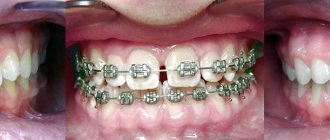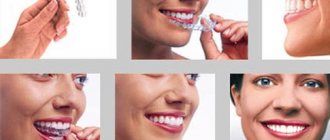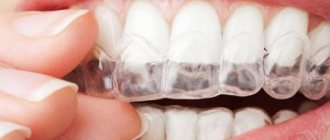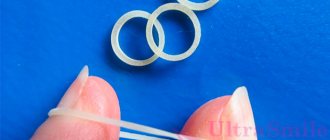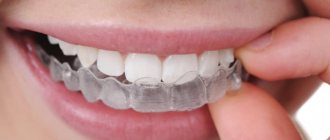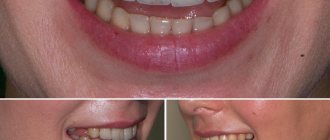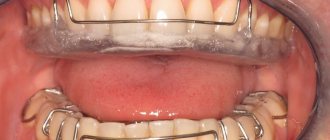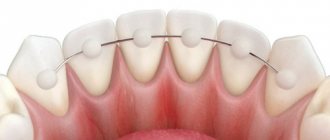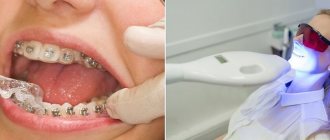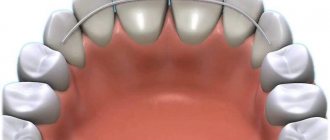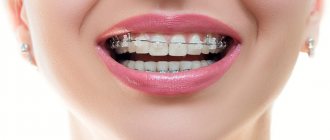Malocclusion is one of the most common problems of the dental system. More than 80% of patients have malocclusion, expressed in one form or another. In many cases, the pathology is not pronounced and generally does not cause aesthetic discomfort to the patient, so the patient is in no hurry to correct the bite in dentistry. It is important to understand that bite problems, even the most minor ones, must be corrected, since any anomaly affects the normal functioning of the entire dental system.
Why do you need a dental guard after braces?
Braces correct the bite. This may take several months or even years. When the orthodontic appliance is finally removed, the patient experiences relief. But not everyone knows that after removing braces, teeth can return to their previous incorrect position. This is due to the structural features of the jaw and the physiology of the body, for which it is natural to resist outside interference.
In this article
- Why do you need a dental guard after braces?
- Types of removable mouthguards
- Advantages and disadvantages of removable aligners
- How is an orthodontic mouth guard installed?
- How long do you wear mouthguards after braces?
- How to care for aligners after braces?
- How to wear mouth guards after braces without damaging them?
- Conclusion
In order to prevent repeated curvature of teeth and to maintain the effect of bite correction achieved during orthodontic treatment, the orthodontist prescribes the patient to wear retainers. These are special structures that are worn during the retention period - a time when there is a risk of the tooth returning to its usual position. Retainers hold the teeth in the desired position and allow the ligaments to “get used” to the new bite.
Retainers are removable and non-removable. The latter are wires fixed on the inside of the teeth. A more convenient and popular option is a removable orthodontic mouthguard - after braces, it is worn only at night.
If there is strong bite resistance, the orthodontist may recommend wearing both removable mouth guards after braces and permanent retainers at the same time. In this case, the wire is worn constantly, and the mouth guard is worn only for a certain time at night or during the day.
Kinds
There are several types of mouthguards that differ in their functionality. Let's look at each of them in more detail:
- Positioning. They place the teeth and jaw arches in the correct position in relation to each other.
- Relaxation. They help relax the chewing muscles, align the location of the joint and improve neuromuscular balance.
- Decompression. They relieve muscle hypertonicity during its uncontrolled contraction, normalize the occlusal load on the dentition, and prevent tooth abrasion. Most often prescribed for bruxism.
- Stabilizing. They return the lower jaw to the correct position, promote the movement of the condyle to the center of the temporomandibular joint, and create correct contact between the teeth.
- Replicating. Correct the position of the jaws and individual teeth (if they are displaced or rotated).
Wearing relaxation mouth guards is possible in combination with braces.
The mouth guard is installed on one jaw or on both jaws at once. In each specific clinical case, the doctor selects the option that will have the desired therapeutic effect.
Types of removable mouthguards
Dental mouthguards differ in material, duration of wear, and production technology:
- Standard models are made according to one sample and do not take into account the specifics of an individual bite. Therefore, they are rarely used after braces. These types of trays are often used for teeth whitening.
- Thermally modeled retainers. Their peculiarity is that they take the unique shape of teeth after heating. Such a mouth guard is first placed in hot water and only then put on the jaw.
- Individual models are the most accurate and convenient. They are made according to the individual anatomical parameters of a particular patient based on a cast of the jaw.
According to the period of wearing, mouthguards are available at night and around the clock. The first ones are worn exclusively at night and are used in “mild” cases of bite correction. They are worn around the clock, removed only during meals and before oral hygiene. These models are suitable for correcting severe malocclusions.
According to the material, mouthguards can be made of silicone and bioplastic. Both options are distinguished by good hypoallergenic properties, transparency and non-invasiveness.
What materials are the protection plates made from?
Every athlete sooner or later faces the question: “What material is better to buy a mouth guard from?”
- The most inexpensive are mouthguards made of latex or rubber. As a rule, cast plates are made from this material. Professional athletes do not use such mouthguards due to their inability to reliably protect against serious injuries.
- The average price option is plates made of silicone. They are boiled, and therefore are able to take into account the anatomical features of the athlete’s jaw. These mouthguards are used by mid-level fighters.
- Mouthguards for professional athletes are made from gel-like materials. This material allows you to accurately copy the shape of the athlete’s jaw, and during the fight it provides a high degree of protection.
It is also worth noting that a number of requirements are imposed on the mouth guards of professional fighters. If the plates used by the athlete are not able to provide the fighter with a certain level of protection, then the athlete is simply not allowed to compete.
Advantages and disadvantages of removable aligners
Caps have many advantages:
- unlike fixed structures, they can be worn for a limited time;
- using mouthguards after braces is more comfortable, since the jaw “rests” from metal structures;
- Oral care is easier if the retainer can be removed.
The main disadvantage of aligners is that they are a noticeable design that affects appearance, so not everyone is ready to wear such retainers during the day. In addition, the design can cause increased salivation.
How is an orthodontic mouth guard installed?
The removable retainer is placed by the orthodontist for the first time; in the future, this can be done by the patient himself. Before the first installation, the doctor prepares the oral cavity for the installation of an orthodontic structure. Checks that the braces system does not damage tooth enamel, evaluates the presence of carious lesions, and covers the teeth with a special protective layer.
A custom-made or thermally modeled mouth guard is placed on the patient's teeth and shown how to remove and put it on independently.
Manufacturers
Mouthguards are produced by many companies around the world. Let's take a closer look at the products of the most popular companies.
- Invisalign. The production of these orthodontic structures is carried out by the American company Align Technology. This is a true leader in the aligner market. When manufacturing devices, a 3D model of the patient’s jaw is taken as a basis.
- Ortosnap. A more budget-friendly option than Invisalign. The company uses patented Dinamic Physical Model technology in the manufacture of devices. Each section of the product has a different thickness.
- Invisible All In. Mouth guards made in Italy. Layer-by-layer technology is used to ensure even pressure on the teeth.
- Clear Correct. Aligners are widely used among patients prone to allergies. The American company uses a special hypoallergenic material for their manufacture.
Mouthguards help to quickly and effectively cope with bite defects. They are considered a worthy alternative to braces.
How long do you wear mouthguards after braces?
The most common question that patients ask their orthodontist is how long to wear mouth guards after removing braces. For each person, the wearing period is individual and determined by the doctor. For some, a year is enough to fix the bite; for others, it takes more than two years. If you want to roughly calculate how long you need to wear mouthguards after braces, you can use this conditional formula.
Take as a basis the time during which you wore the braces system and double it. This will be the approximate period of wearing the mouthguard. Many people wear it for two to four years. But there are also people whose muscle memory “refuses to remember” the new position of the jaw; the process of fixing the bite is very slow. In this case, you may need to wear a mouth guard for a longer period, sometimes for life.
How to care for aligners after braces?
Oral care when wearing orthodontic appliances should be as thorough as possible to avoid caries and other dental damage. Therefore, when installing retainers, the orthodontist must tell the patient how to properly care for the aligners. Below are basic rules for safe cleaning of orthodontic trays and oral care.
The aligners must be removed twice a day during morning and evening brushing. After removing the structure, you must thoroughly brush your teeth with a brush and paste, clean the interdental spaces with floss, floss or irrigator, and remove plaque from the gums, tongue, and inner surface of the cheeks.
The mouthguard itself is also carefully cleaned with a brush and paste, removing plaque and dirt from it. Once every seven days the structure is treated with a special disinfectant. It is also recommended to use mouthwash more often when wearing removable retainers.
Possible cost
It’s hard to talk about the cost of the entire course. It can cost the patient 80 or 300 thousand rubles. The final cost depends on many aspects of treatment. The main one is the duration of treatment. For individual production, the price of one plate is taken into account. On average, one mouth guard is worn for 2 weeks, after which it is replaced with the next one. The duration of the entire course can be 6 – 20 months. Correcting a bite in children with mouthguards occurs faster due to the jaw not yet fully formed.
Also, how prestigious the clinic is will play an important role in the final cost. Different medical institutions may vary in the cost of providing this service.
In addition to the price of manufacturing the trays themselves, the following is taken into account:
- consultation and diagnosis by an orthodontist at the first visit:
- prescription of treatment after the second visit;
- diagnostics and creation of impressions;
- cost of work for making mouth guards;
- additional follow-up consultations.
In addition to the design itself, the patient will have to purchase additional related products such as pastes intended for cleaning the plates, cases for storing them, as well as enamel whitening gel.
As a result, the cost of a mouthguard to correct your bite will be decent. But don't forget about all the benefits. In addition to the excellent final result, the mouth guards are invisible and comfortable to wear, do not injure the oral cavity and are easy to use.
Sources used:
- Guide to pediatric dentistry. — M.: Medicine
- Widmer, R. Handbook of Pediatric Dentistry / Edited by A. Cameron, R. Widmer. — M.: MEDpress-inform
- Novik, I. O. Diseases of the teeth and oral mucosa in children / I. O. Novik. — M.: Medicine
How to wear mouth guards after braces without damaging them?
Mouthguards are made of plastic material, so they can be easily damaged if handled carelessly. In this case, the device will no longer perform its main task - to hold the teeth in the correct position. If it breaks, it cannot be repaired; a new one will have to be made. Therefore, it is important to follow the rules of safe operation.
How to wear a mouthguard correctly:
- To avoid damage, it must be removed before each meal.
- Plastic aligners do not withstand high temperatures well, so you should not drink hot tea, coffee or other drinks with an orthodontic structure in your mouth.
- Between uses, the mouthguards are worn like other personal care products - in special lockable containers. This protects the device from contamination and damage.
- You cannot smoke with a mouth guard in your mouth, because tobacco smoke and tar change the color and structure of the material. The mouth guard becomes cloudy and less flexible.
- The structure is stored at room temperature. Both heat and cold negatively affect its characteristics.
